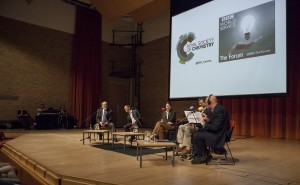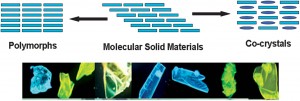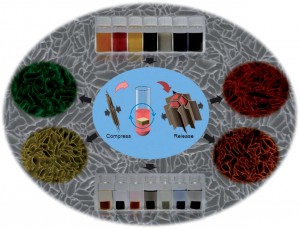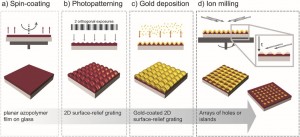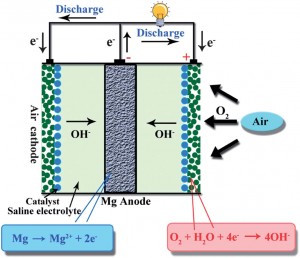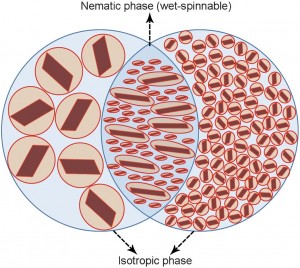Self-Assembly of Aligned Rutile@Anatase TiO2 Nanorod@CdS Quantum Dots Ternary Core-Shell Heterostructure: Cascade Electron-Transfer by Interfacial Design
Fang-Xing Xiao, Jianwei Miao and Bin Liu
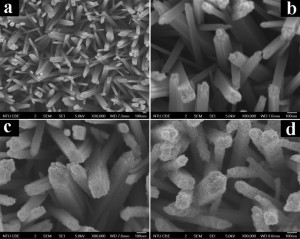 A novel self-assembly approach based on electrostatic interaction has been developed for the synthesis of rutile@anatase TiO2 nanorod (NR)@CdS quantum dots (QDs) ternary core-shell heterostructure, for which in-situ formed monodispersed anatase TiO2 layer was intimately sandwiched between rutile TiO2 NRs and CdS QDs. It has been demonstrated that the well-defined bilayer interface significantly improves the photocatalytic performance of the ternary heterostructure (i.e. rutile@anatase TiO2 NR@CdS QDs), owing predominantly to the appropriate band alignment of constituting semiconductors, thus facilitating photogenerated electron-hole separation and charge collection under simulated solar light irradiation.
A novel self-assembly approach based on electrostatic interaction has been developed for the synthesis of rutile@anatase TiO2 nanorod (NR)@CdS quantum dots (QDs) ternary core-shell heterostructure, for which in-situ formed monodispersed anatase TiO2 layer was intimately sandwiched between rutile TiO2 NRs and CdS QDs. It has been demonstrated that the well-defined bilayer interface significantly improves the photocatalytic performance of the ternary heterostructure (i.e. rutile@anatase TiO2 NR@CdS QDs), owing predominantly to the appropriate band alignment of constituting semiconductors, thus facilitating photogenerated electron-hole separation and charge collection under simulated solar light irradiation.
Mater. Horiz., 2013, DOI: 10.1039/c3mh00097d, Accepted Manuscript
Supramolecular host–guest polymeric materials for biomedical applications
Xian Jun Loh
The bottom–up synthesis of highly complex functional materials from simple modular blocks is an intriguing area of research. Driven by the chemistry of supramolecular assembly, modules which self-assemble into intricate structures have been described. These hierarchically assembled systems extend beyond the individual molecule and rely on non-covalent interactions in a directed self-assembly process. The intrinsic properties of the materials can be modified by exploiting the dynamic and specific uni-directional interactions among the building. This also allows the building of novel supramolecular structures such as hydrogels, micelles and vesicles. These aqueous supramolecular networks belong to a novel category of soft biomaterials exhibiting attractive properties such as stimuli-responsiveness and self-healing properties derived from their dynamic behavior. These are important for a wide variety of emerging applications. In this review, the latest literature describing the formation of dynamic polymeric networks through host–guest complex formation will be summarised. These approaches carried out in the aqueous medium have unlocked a versatile toolbox for the design and fine-tuning of supramolecular self-assembled materials.
Mater. Horiz., 2014, DOI: 10.1039/c3mh00057e, Advanced Article
Protein coronas suppress the hemolytic activity of hydrophilic and hydrophobic nanoparticles
Krishendu Saha, Daniel Moyano and Vincent M Rotello
 The role of nanoparticle surface hydrophobicity on its hemolytic property is established in the absence and the presence of plasma proteins. Significantly, the formation of plasma protein corona on NP surface protects red blood cells from both hydrophilic and hydrophobic NP-mediated hemolysis.
The role of nanoparticle surface hydrophobicity on its hemolytic property is established in the absence and the presence of plasma proteins. Significantly, the formation of plasma protein corona on NP surface protects red blood cells from both hydrophilic and hydrophobic NP-mediated hemolysis.
Mater. Horiz., 2013, DOI: 10.1039/c3mh00075c, Accepted Manuscript
Dendrimer-linked, renewable and magnetic carbon nanotube aerogels
Xuetong Zhang, Liang Chen, Tianyu Yuan, Huan Huang, Zhuyin Sui, Ran Du, Xin Li, Yun Lua and Qingwen Lib
Magnetic carbon nanotube aerogels with a repeated aerogel–sol–hydrogel–aerogel transition have been acquired by the special drying of gel-precursors made via assembling individual nanotubes with dendritic poly(amido amine) molecules in the presence of Fe3O4 nanoparticles, which has inspired us to synthesize renewable 3D porosints composed of organic, inorganic and their hybrid building blocks.
Mater. Horiz., 2014, DOI: 10.1039/c3mh00076a, Advanced Article


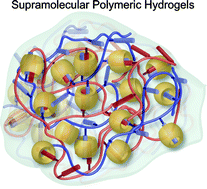
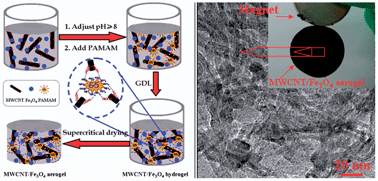









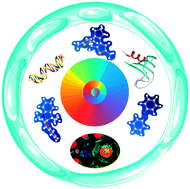 Photochromic materials are a family of compounds which undergo photo-reversible transformations between two different isomers with distinct physical and chemical properties. Most smart photochromic materials have been exploited in research areas such as electro-optical functional materials, while recently their applications have extended to novel bio-materials. Biological systems, such as tissue/cellular imaging, nucleotides, peptides, ion channels, etc., have emerged as a revolutionary research frontier for photochromic materials since both covalent coupling and non-covalent interactions with bio-molecules have been achieved. This review commences with a brief description of exciting progress in this field, and describes strategies for using photochromic functional molecules from bio-sensing and cell imaging to optical manipulation of bio-macromolecules (nucleotides, peptides, ion channels, GFP, etc.). Further development of these photo-switches as well as remaining challenges are also discussed and put in prospect.
Photochromic materials are a family of compounds which undergo photo-reversible transformations between two different isomers with distinct physical and chemical properties. Most smart photochromic materials have been exploited in research areas such as electro-optical functional materials, while recently their applications have extended to novel bio-materials. Biological systems, such as tissue/cellular imaging, nucleotides, peptides, ion channels, etc., have emerged as a revolutionary research frontier for photochromic materials since both covalent coupling and non-covalent interactions with bio-molecules have been achieved. This review commences with a brief description of exciting progress in this field, and describes strategies for using photochromic functional molecules from bio-sensing and cell imaging to optical manipulation of bio-macromolecules (nucleotides, peptides, ion channels, GFP, etc.). Further development of these photo-switches as well as remaining challenges are also discussed and put in prospect.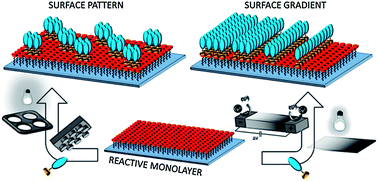 This review describes the progress of the development of surface chemical reactions for the modification of self-assembled monolayers (SAMs) and the fabrication of surface chemical gradients. Various chemical reactions can be carried out on SAMs to introduce new functionalities. “Click” reactions, which are highly efficient and selective, have largely contributed to the development and implementation of surface chemical reactions in the fields of biotechnology, drug discovery, materials science, polymer synthesis, and surface science. Besides full homogeneous functionalization, SAMs can be modified to exhibit a gradual variation of physicochemical properties in space. Surface-confined chemical reactions can be used for the fabrication of surface chemical gradients making the preparation of exceptionally versatile interfaces accessible.
This review describes the progress of the development of surface chemical reactions for the modification of self-assembled monolayers (SAMs) and the fabrication of surface chemical gradients. Various chemical reactions can be carried out on SAMs to introduce new functionalities. “Click” reactions, which are highly efficient and selective, have largely contributed to the development and implementation of surface chemical reactions in the fields of biotechnology, drug discovery, materials science, polymer synthesis, and surface science. Besides full homogeneous functionalization, SAMs can be modified to exhibit a gradual variation of physicochemical properties in space. Surface-confined chemical reactions can be used for the fabrication of surface chemical gradients making the preparation of exceptionally versatile interfaces accessible.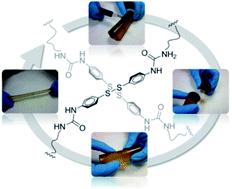
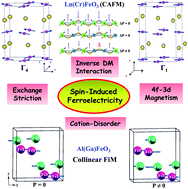 A few oxides such as YMnO3, TbMnO3, YMn2O5 and BiFeO3 constituted the small family of well-characterized multiferroics until recently, but this area of research has been enlarged significantly due to the advent of a novel class of oxides exhibiting interesting multiferroic and magnetoelectric properties arising from magnetically induced ferroelectricity. Interestingly, these materials are simple transition metal oxides, most of them possessing the perovskite structure. In this review article, we present the significant features of multiferroic and magnetoelectric ferrites and chromites which owe their ferroelectricity to magnetic interactions. Some of the important systems discussed are BiFeO3 whose properties are affected by magnetic and electric fields, rare-earth orthoferrites LnFeO3 (Ln = Dy, Gd and Sm) and rare-earth orthochromites LnCrO3, where exchange-striction plays a significant role. Perovskite oxides of the type Y(A1−xBx)O3 (A, B = Fe, Cr, Mn) exhibit multiferroic properties, although the existence of these properties in YFeO3 and YCrO3 is in doubt. Such oxides with a non-magnetic rare-earth cation at the A site and two transition metal ions in the B-site permit tuning the transition temperatures by varying the B site ions and their relative proportions or the Ln ion. Multiferroic properties of simple ferrites such as Al(Ga)FeO3 where cation disorder appears to play a role are also discussed. Problems and challenges in this area of research are indicated.
A few oxides such as YMnO3, TbMnO3, YMn2O5 and BiFeO3 constituted the small family of well-characterized multiferroics until recently, but this area of research has been enlarged significantly due to the advent of a novel class of oxides exhibiting interesting multiferroic and magnetoelectric properties arising from magnetically induced ferroelectricity. Interestingly, these materials are simple transition metal oxides, most of them possessing the perovskite structure. In this review article, we present the significant features of multiferroic and magnetoelectric ferrites and chromites which owe their ferroelectricity to magnetic interactions. Some of the important systems discussed are BiFeO3 whose properties are affected by magnetic and electric fields, rare-earth orthoferrites LnFeO3 (Ln = Dy, Gd and Sm) and rare-earth orthochromites LnCrO3, where exchange-striction plays a significant role. Perovskite oxides of the type Y(A1−xBx)O3 (A, B = Fe, Cr, Mn) exhibit multiferroic properties, although the existence of these properties in YFeO3 and YCrO3 is in doubt. Such oxides with a non-magnetic rare-earth cation at the A site and two transition metal ions in the B-site permit tuning the transition temperatures by varying the B site ions and their relative proportions or the Ln ion. Multiferroic properties of simple ferrites such as Al(Ga)FeO3 where cation disorder appears to play a role are also discussed. Problems and challenges in this area of research are indicated.